The first flags of Rhodesia were
of the standard British colonial pattern. During the period of
the British South Africa Company's rule, the Union Jack was the
proper flag of nationality. It was often flown together with the
Company's flag, a Union Jack defaced with the BSAC badge. This
also served as the flag of the Company's regional
administrators. When the British government assumed direct
control, Southern Rhodesia, as it then was called, received a
British Blue Ensign with the shield of the colony's arms in the
fly. Originally this was on a white circular background, which
was later deleted. The original flag of the Governor of Southern
Rhodesia was unusual in that there was no garland surrounding
the shield of the arms. In 1952 it was replaced by a blue flag
displaying a royal crown, first the Tudor Crown and then, as
shown, St. Edward's Crown, the style preferred by Queen
Elizabeth II. This flag was not used after Rhodesia's unilateral
declaration of independence in 1965.
Shortly after the Federation of
Rhodesia and Nyasaland was dissolved in 1963, Southern Rhodesia
adopted a new flag with the field changed from dark blue to
light blue, and it remained in use until 1968.
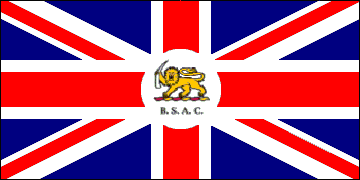
British South Africa Company • Regional Administrator's
Flag 1890-1923 |
|
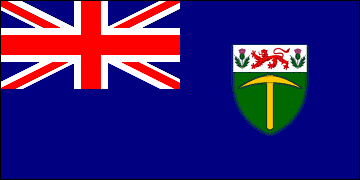
Southern Rhodesia • Government Flag
1924-64 |
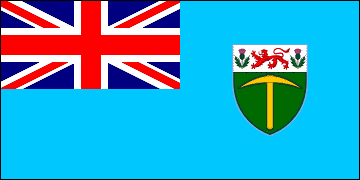
Southern Rhodesia • Government Flag
1964-68 |
|

Southern Rhodesia • Governor's Flag
1924-52 |
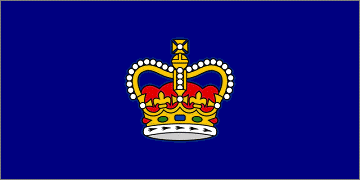
Southern Rhodesia • Governor's Flag
1952-65 |
|
FEDERATION OF RHODESIA AND NYASALAND |
The Federation of Rhodesia and Nyasaland, also
called the Central African Federation, had a complex
governmental structure. Its three component parts maintained
their existing governments, with the Federation government,
headed by a Governor-General representing the Crown, responsible
for certain specified matters, e.g. defense. The Federation's
coat of arms, the shield of which was placed in the fly of the
government flag, combined elements of the arms of the three
territories. The flag of the Governor-General was of the
standard pattern introduced for that office in 1931. Northern
Rhodesia, Southern Rhodesia and Nyasaland retained their
existing flags.
|
|
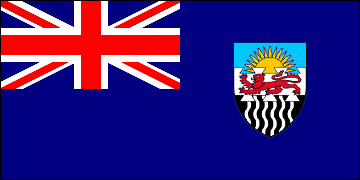
Government Flag 1953-63 |
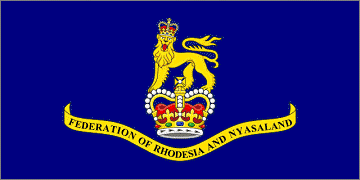
Governor-General's Flag 1953-63 |
REPUBLIC OF RHODESIA
• ZIMBABWE RHODESIA
With the dissolution of the
Federation in 1963, all three of its members were slated for
full independence. This caused no particular problems in the
protectorates of Northern Rhodesia and Nyasaland, whose white
European populations were small. They became independent as
Zambia and Malawi in 1964. But the situation in the
self-governing colony of Southern Rhodesia was quite different.
In 1963 a tenth of the colony's population was white, mostly of
British origin. These people rejected the British government's
policy of "no independence before majority rule," arguing that
the black population was unprepared to assume responsibility for
Southern Rhodesia, which by African standards boasted an
advanced economy. Both the British government and the majority
of black Rhodesians rejected the white minority's preferred
policy: a gradual, step-by-step transition to majority rule.
Negotiations in pursuit of a compromise soon broke down, and the
result was a unilateral declaration of independence (UDI) by
Rhodesia's white minority government on November 11, 1965. The
Rhodesian government proclaimed its continuing loyalty to the
Crown, hoping to achieve dominion status on a par with Canada,
Australia and New Zealand, but this was unacceptable to both
Britain and the black majority. Further negotiations went
nowhere and in 1970, Rhodesia declared itself to be a republic,
severing its formal connection to the British Crown. Two years
previously, it had adopted a new flag: vertical stripes of
green, white and green with the full national arms on the white
stripe. The republican constitution provided for a president in
the role of head of state, whose flag displayed the full arms on
a light blue field.
UDI signaled the beginning of
an insurgency by black nationalist groups, with the Zimbabwe
African National Union-Patriotic Front (ZANU-PF) in the lead.
The Bush War, is it came to be called, was a minor annoyance at
first, but as the years passed it grew and spread. In 1979 the
Rhodesian government, bowing to the inevitable, signed an
agreement with several moderate black parties not involved in
the insurgency. This Internal Settlement, as it was called,
enfranchised Rhodesia's black majority for the first time. The
country was renamed Zimbabwe Rhodesia after Great Zimbabwe, an
Iron Age city thought to have been the seat of a local monarch.
A new national flag was adopted, with horizontal stripes of red,
white and green plus a vertical black stripe at the hoist. In
the upper hoist was placed a representation of the Zimbabwe
Bird, modeled after a soapstone statuette found in the ruins of
the ancient city. This flag was dropped after the Lancaster
Agreement returned the country to British rule pending
internationally recognized independence as the Republic of
Zimbabwe, but it remained in unofficial use during the
transition.
|
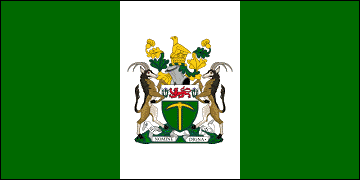
National Flag 1968-79 |
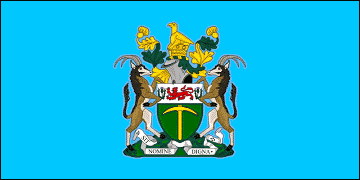
Presidential Flag 1968-79 |
|
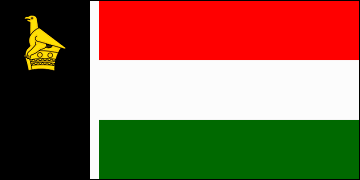
National Flag 1979 |
|
REBUBLIC OF ZIMBABWE
|
With the transformation of Zimbabwe Rhodesia into the
Republic of Zimbabwe, a new nationl flag was introduced, striped
horizontzlly with the colors of the Zimbabwe African National
Union-Patriotic Front (ZANU-PF), the principal black nationalist
independence party On a white, black-edged triangle at the hoist
was placed a represemntation of the Zimbabwe Bird over a red
star. The red star represents the independence struggle and
socialism. The first presidential flag was simply the national
flag with the full arms of Zimbabwe on a white panel in the fly;
it was replaced by a new model in 1986. ZANU-PF became Ziimbabwe's ruling
political party and its flag acquired official status.
|
|
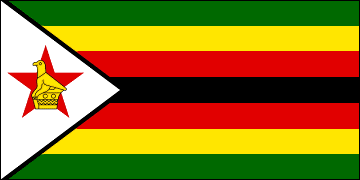
National Flag
Since 1980 |
|
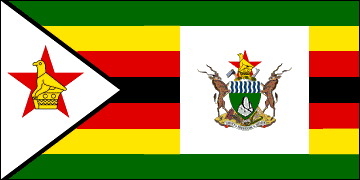
Presidential Flag
1981-86 |
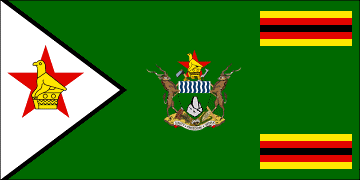
Presidential Flag
Since 1986 |
|
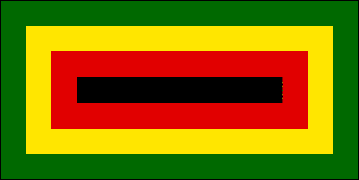
Flag of
ZANU-PF
|













